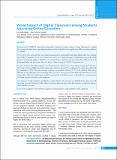Please use this identifier to cite or link to this item:
https://hdl.handle.net/20.500.14356/898Full metadata record
| DC Field | Value | Language |
|---|---|---|
| dc.contributor.author | Dahal, Hira Nath | - |
| dc.contributor.author | Ranju (Sitaula), Kharel | - |
| dc.date.accessioned | 2023-04-04T08:09:39Z | - |
| dc.date.available | 2023-04-04T08:09:39Z | - |
| dc.date.issued | 2022 | - |
| dc.identifier.citation | DahalH. N., & Kharel (Sitaula) R. (2022). Visual Impact of Digital Classroom among Students Attending Online Education. Journal of Nepal Health Research Council, 20(02), 405-411. https://doi.org/10.33314/jnhrc.v20i02.4041 | en_US |
| dc.identifier.issn | Print ISSN: 1727-5482; Online ISSN: 1999-6217 | - |
| dc.identifier.uri | http://103.69.126.140:8080/handle/20.500.14356/898 | - |
| dc.description | Original Article | en_US |
| dc.description.abstract | Abstract Background: COVID-19 outbreak has changed the traditional teaching method of using blackboards to digital devices assisted online classes. Spending long hours in front of digital devices might lead to different ocular problems in children. Methods: A cross-sectional study was conducted among school-going children attending digital online classes during the COVID-19 pandemic. A web-based online form was used to evaluate the impact of digital classrooms on the visual status of school-going children. Children were selected from 5 randomly selected schools from different parts of Kathmandu Valley who had online classes for at least 2 hours during the COVID-19 pandemic era. Results: A total of 303 usable responses were obtained from a response rate of 41% with an average age of 10 years. Sixty-four percent of children had online classes up to 6 hours a day and 44% used laptops for online classes followed by smartphones (38%). The most common symptom was headache affecting 39.3% of the children, followed by difficulty seeing bright light (35%) and itching of the eyes (35%). Forty percent of the children felt that their eyes were affected after online class. Multivariate analysis showed that the total duration spent on digital devices was the greatest risk factor associated with the ocular symptoms. Conclusions: Ocular symptoms and digital eye strain related to the excessive use of digital devices have increased due to the increased duration of online classes. Awareness about the prevention and measures to reduce the adverse effects should be stressed. Keywords: Computer vision syndrome; digital eye strain; headache; ocular problems; online classroom | en_US |
| dc.language.iso | en | en_US |
| dc.publisher | Nepal Health Research Council | en_US |
| dc.relation.ispartofseries | April-June, 2022;4041 | - |
| dc.subject | Computer vision syndrome | en_US |
| dc.subject | Digital eye strain | en_US |
| dc.subject | Headache | en_US |
| dc.subject | Ocular problems | en_US |
| dc.subject | Online classroom | en_US |
| dc.title | Visual Impact of Digital Classroom among Students Attending Online Education | en_US |
| dc.type | Journal Article | en_US |
| Appears in Collections: | Vol 20 No 02 Issue 55 April-June, 2022 | |
Files in This Item:
| File | Description | Size | Format | |
|---|---|---|---|---|
| 4041-Manuscript-29688-1-10-20221103.pdf | Full Article. | 226.7 kB | Adobe PDF |  View/Open |
Items in DSpace are protected by copyright, with all rights reserved, unless otherwise indicated.
